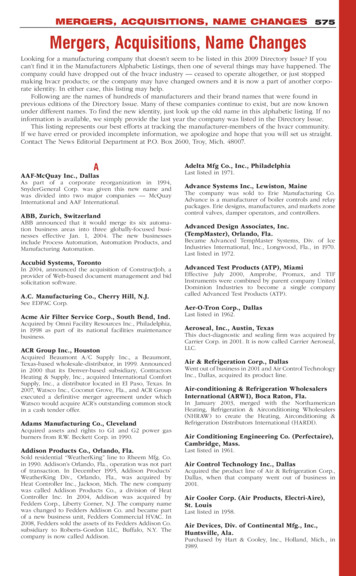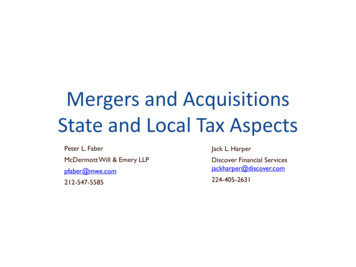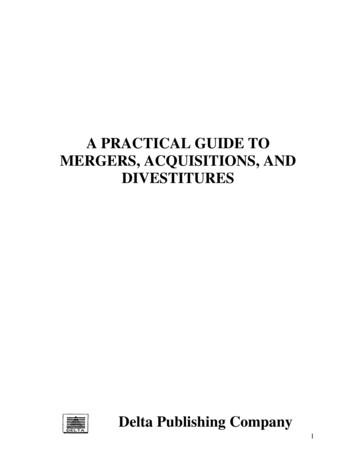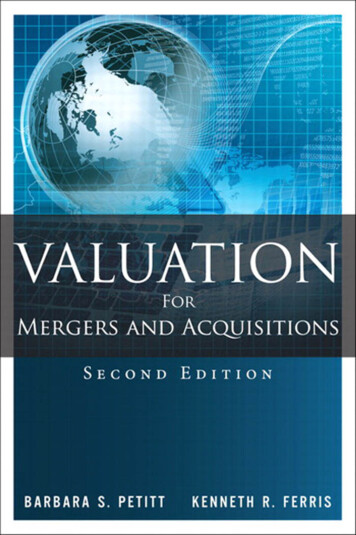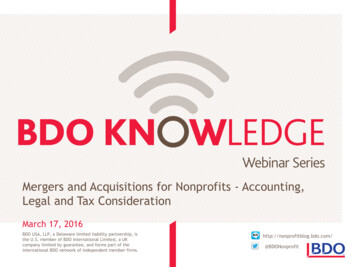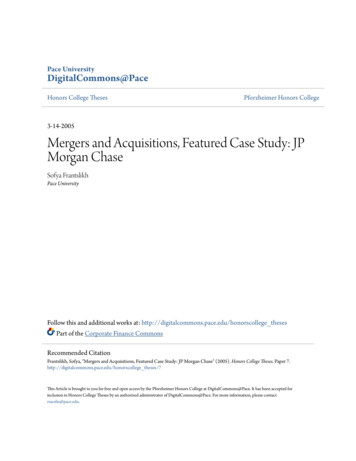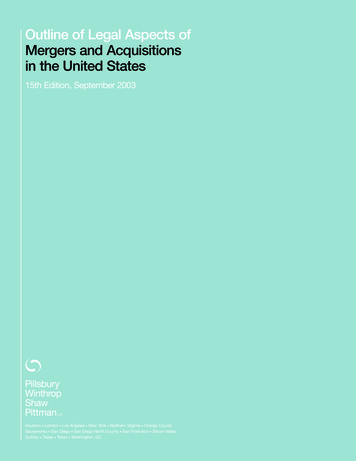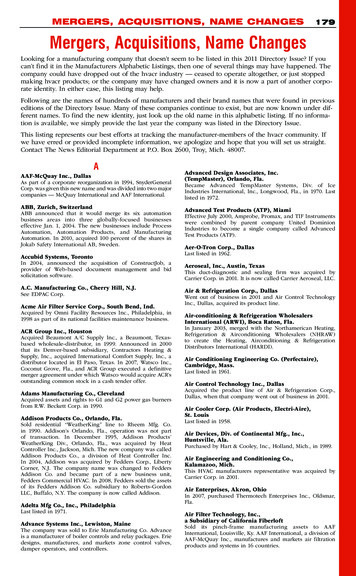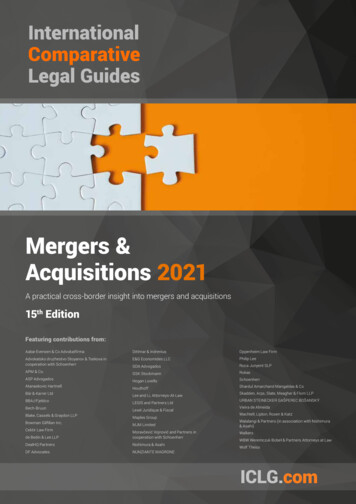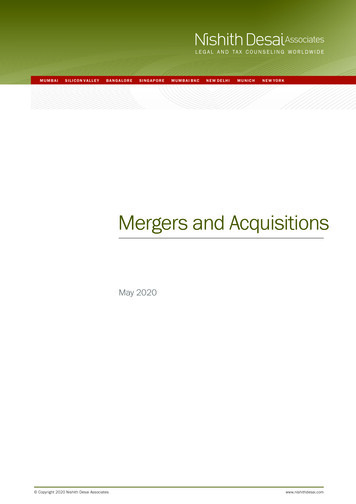
Transcription
MUMBAISI LI C O N VALLE YBAN G A LO RESI N G A P O REMUMBAI BKCNEW DELHIMUNICHNE W YO RKMergers and AcquisitionsMay 2020 Copyright 2020 Nishith Desai Associateswww.nishithdesai.com
Mergers and AcquisitionsMay 2020ndaconnect@nishithdesai.comDMS Code -563392.1 Nishith Desai Associates 2020
Mergers and AcquisitionsAbout NDAWe are an India Centric Global law firm (www.nishithdesai.com) with four offices in India and theonly law firm with license to practice Indian law from our Munich, Singapore, Palo Alto and New Yorkoffices. We are a firm of specialists and the go-to firm for companies that want to conduct businessin India, navigate its complex business regulations and grow. Over 70% of our clients are foreignmultinationals and over 84.5% are repeat clients.Our reputation is well regarded for handling complex high value transactions and cross borderlitigation; that prestige extends to engaging and mentoring the start-up community that wepassionately support and encourage. We also enjoy global recognition for our research with an abilityto anticipate and address challenges from a strategic, legal and tax perspective in an integrated way. Infact, the framework and standards for the Asset Management industry within India was pioneered byus in the early 1990s, and we continue to remain respected industry experts.We are a research based law firm and have just set up a first-of-its kind IOT-driven Blue Sky Thinking& Research Campus named Imaginarium AliGunjan (near Mumbai, India), dedicated to exploring thefuture of law & society. We are consistently ranked at the top as Asia’s most innovative law practice byFinancial Times. NDA is renowned for its advanced predictive legal practice and constantly conductsoriginal research into emerging areas of the law such as Blockchain, Artificial Intelligence, DesignerBabies, Flying Cars, Autonomous vehicles, IOT, AI & Robotics, Medical Devices, Genetic Engineeringamongst others and enjoy high credibility in respect of our independent research and assist number ofministries in their policy and regulatory work.The safety and security of our client’s information and confidentiality is of paramount importanceto us. To this end, we are hugely invested in the latest security systems and technology of militarygrade. We are a socially conscious law firm and do extensive pro-bono and public policy work. Wehave significant diversity with female employees in the range of about 49% and many in leadershippositions. Nishith Desai Associates 2020
Provided upon request onlyAccoladesA brief chronicle of our firm’s global acclaim for its achievements and prowess through the years – Legal500: Tier 1 for Tax, Investment Funds, Labour & Employment, TMT and Corporate M&A2020, 2019, 2018, 2017, 2016, 2015, 2014, 2013, 2012 Chambers and Partners Asia Pacific: Band 1 for Employment, Lifesciences, Tax and TMT2020, 2019, 2018, 2017, 2016, 2015 IFLR1000: Tier 1 for Private Equity and Project Development: Telecommunications Networks.2020, 2019, 2018, 2017, 2014 AsiaLaw Asia-Pacific Guide 2020: Tier 1 (Outstanding) for TMT, Labour & Employment, PrivateEquity, Regulatory and Tax FT Innovative Lawyers Asia Pacific 2019 Awards: NDA ranked 2nd in the Most Innovative LawFirm category (Asia-Pacific Headquartered) RSG-Financial Times: India’s Most Innovative Law Firm 2019, 2017, 2016, 2015, 2014 Benchmark Litigation Asia-Pacific: Tier 1 for Government & Regulatory and Tax 2019, 2018 Who’s Who Legal 2019:Nishith Desai, Corporate Tax and Private Funds – Thought LeaderVikram Shroff, HR and Employment Law- Global Thought LeaderVaibhav Parikh, Data Practices - Thought Leader (India)Dr. Milind Antani, Pharma & Healthcare – only Indian Lawyer to be recognized for‘Life sciences-Regulatory,’ for 5 years consecutively Merger Market 2018: Fastest growing M&A Law Firm in India Asia Mena Counsel’s In-House Community Firms Survey 2018: The only Indian Firm recognizedfor Life Sciences IDEX Legal Awards 2015: Nishith Desai Associates won the “M&A Deal of the year”, “Best DisputeManagement lawyer”, “Best Use of Innovation and Technology in a law firm” and “Best DisputeManagement Firm” Nishith Desai Associates 2020
Mergers and AcquisitionsPlease see the last page of this paper for the most recent research papers by our experts.DisclaimerThis report is a copy right of Nishith Desai Associates. No reader should act on the basis of anystatement contained herein without seeking professional advice. The authors and the firm expresslydisclaim all and any liability to any person who has read this report, or otherwise, in respect ofanything, and of consequences of anything done, or omitted to be done by any such person in relianceupon the contents of this report.ContactFor any help or assistance please email us on ndaconnect@nishithdesai.comor visit us at www.nishithdesai.comAcknowledgementsAishwarya Haishwarya.h@nishithdesai.comPoonam Sharmapoonam.sharma@nishithdesai.comAditya Desaiaditya.desai@nishithdesai.comAfaan Arshadafaan.arshad@nishithdesai.comVinay Shuklavinay.shukla@nishithdesai.comHarshita chal Joshipuranishchal.joshipura@nishithdesai.com Nishith Desai Associates 2020
Mergers and 101MERGERS AND AMALGAMATIONS: KEY CORPORATE ANDSECURITIES LAWS CONSIDERATIONS04I.II.04056. Nishith Desai Associates 2020Company LawSecurities LawsACQUISITIONS: KEY CORPORATE AND SECURITIES LAWSCONSIDERATIONS07I.II.0710Company LawOther Securities LawsCOMPETITION LAW18I.II.III.181818Anti-Competitive AgreementsAbuse of Dominant PositionRegulation of CombinationsEXCHANGE CONTROL22I.II.III.2229IV.5.Overview of the M&A MarketConceptual OverviewForeign Direct InvestmentIndirect Foreign Investment; Downstream investmentTransfer of equity instruments of an Indian company by orto a person resident outside IndiaOverseas Direct Investment2931TAXES AND DUTIES35I.II.III.354343Income Tax Act, 1961Goods and Services TaxStamp DutyCONCLUSION45
Mergers and Acquisitions1. IntroductionI. Overview of the M&AMarketWith a few highs and lows, the merger andacquisition (“M&A”) activity in India duringthe period from 2015-2019 has been largelyresilient. During this period, India has witnessedmore than 3,600 M&A deals with an aggregatevalue of more than USD 310 billion.1Sectors such as industrial goods, energy, telecom& media represented more than 60% of dealsby volume and value.2 A few of the largest dealsinclude Walmart’s USD 16 billion acquisition ofFlipkart (2018), the USD 13 billion acquisitionof Essar Oil by a Rosneft-led Russian consortium(2017), and Adani Transmission’s USD 3 billionacquisition of Reliance Infrastructure’s integratedMumbai power distribution business (2018).3The second term of the Modi government broughtback tremendous faith in investor community inIndia. The government’s reform agenda and thepolicies were largely formulated to encourageforeign investments. There was also a surgein M&A activity due to the new bankruptcylaw, the faster pace of approvals initiated by thegovernment as part of its ease of doing businessin India campaign and the relaxation in ForeignDirect Investment (“FDI”) norms.However, India started seeing a slump in dealmaking in the third and fourth quarters of2019. Inter alia the US-China trade war, Brexit,the situation in Hong Kong, the drone strikeon Saudi Arabia’s oil facilities had indicated adawning recession.In addition, the COVID-19 outbreak whichdisrupted the world in 2020 has not left theIndian economy untouched. Several M&A dealsin the country have been stalled in the 19/bain report india m a report 2019.pdf2.Ibid.3.Ibid. Nishith Desai Associates 2020of this pandemic including the privatizationof Air India and Bharat Petroleum CorporationLimited. Once the world is able to curtailthe spread of the virus and lift the lockdownacross the globe, countries will look up to theirgovernments to propose measures to revive theeconomy and help revive M&A activity.II. Conceptual OverviewIn this section, we have briefly explained thedifferent types of M&As that may be undertakenand an overview of certain laws that would be ofsignificance to M&A in India.A. Mergers and AmalgamationsThe term ‘merger’ is not defined under theCompanies Act, 2013 (“CA 2013”) or underIncome Tax Act, 1961 (“ITA”). As a concept,‘merger’ is a combination of two or more entitiesinto one; the desired effect being not just theaccumulation of assets and liabilities of thedistinct entities, but organization of such entityinto one business. The possible objectives ofmergers are manifold - economies of scale,acquisition of technologies, access to variedsectors / markets etc. Generally, in a merger, themerging entities would cease to exist and wouldmerge into a single surviving entity.The ITA does however define the analogousterm ‘amalgamation’ as the merger of one ormore companies with another company, or themerger of two or more companies to form onecompany. The ITA goes on to specify certainother conditions that must be satisfied foran ‘amalgamation’ to be eligible for benefitsaccruing from beneficial tax treatment(discussed in Part VI of this Paper).Sections 230-234 of CA 2013 (the “MergerProvisions”) deal with the schemes ofarrangement or compromise between acompany, its shareholders and/or its creditors.These provisions are discussed in greater detailin Part II of this Paper. Commercially, mergers1
Provided upon request onlyand amalgamations may be of several types,depending on the requirements of the mergingentities. Although corporate laws may beindifferent to the different commercial formsof merger/amalgamation, the Competition Act,2002 does pay special attention to the forms.i. Horizontal MergersAlso referred to as a ‘horizontal integration’, thiskind of merger takes place between entitiesengaged in competing businesses which areat the same stage of the industrial process. Ahorizontal merger takes a company a stepcloser towards monopoly by eliminating acompetitor and establishing a stronger presencein the market. The other benefits of this form ofmerger are the advantages of economies of scaleand economies of scope. These forms of mergerare heavily scrutinized by the CompetitionCommission of India (“CCI”).ii. Vertical MergersVertical mergers refer to the combination oftwo entities at different stages of the industrialor production process. For example, the mergerof a company engaged in construction businesswith a company engaged in production ofbrick or steel would lead to vertical integration.Companies stand to gain on account oflower transaction costs and synchronizationof demand and supply. Moreover, verticalintegration helps a company move towardsgreater independence and self-sufficiency.iv. Conglomerate MergersA conglomerate merger is a merger between twoentities in unrelated industries. The principalreason for a conglomerate merger is utilization offinancial resources, enlargement of debt capacity,and increase in the value of outstanding sharesby increased leverage and earnings per share, andby lowering the average cost of capital.4 A mergerwith an unrrelated business also helps thecompany to foray into diverse businesses withouthaving to incur large start-up costs normallyassociated with a new business.v. Cash MergerIn a ‘cash merger’, also known as a ‘cash-outmerger’, the shareholders of one entity receivescash instead of shares in the merged entity.This is effectively an exit for the cashed-outshareholders.vi. Triangular MergerA triangular merger is often resorted to, forregulatory and tax reasons. As the namesuggests, it is a tripartite arrangement in whichthe target merges with a subsidiary of theacquirer. Based on which entity is the survivorafter such merger, a triangular merger maybe forward (when the target merges into thesubsidiary and the subsidiary survives), orreverse (when the subsidiary merges into thetarget and the target survives).B. Acquisitionsiii. Congeneric MergersA congeneric merger is a type of merger wheretwo companies are in the same or relatedindustries or markets but do not offer thesame products. In a congeneric merger, thecompanies may share similar distributionchannels, providing synergies for the merger.The acquiring company and the target companymay have overlapping technology or productionsystems, making for easy integration of the twoentities. This type of merger is often resorted toby entities who intend to increase their marketshares or expand their product lines.2An ‘acquisition’ or ‘takeover’ is the purchase byone person, of controlling interest in the sharecapital or of all or substantially all of the assetsand/or liabilities, of the target. A takeover maybe friendly or hostile and may be structuredeither by way of agreement between the offeror and the majority shareholders or purchase ofshares from the open market or by making anoffer for acquisition of the target’s shares to theentire body of shareholders.4.Ibid, note 4, at p. 59 Nishith Desai Associates 2020
Mergers and AcquisitionsAcquisitions may also be made by way ofacquisition of shares of the target, or acquisitionof assets and liabilities of the target. In the lattercase, entire business of the target may be acquiredon a going concern basis or certain assets andliabilities may be cherry picked and purchasedby the acquirer. The transfer when a business isacquired on a going concern basis is referred toas a ‘slump sale’ under the ITA. Section 2(42C) ofthe ITA defines slump sale as a “transfer of oneor more undertakings as a result of the sale for alump sum consideration without values beingassigned to the individual assets and liabilitiesin such sales”. The legal and tax considerationsof slump sale vis a vis an asset sale is discussed ingreater detail in Part VI of this Paper.Another form of acquisition may be by wayof demerger. A demerger is the opposite of amerger, involving the splitting up of one entityinto two or more entities. An entity which hasmore than one business, may decide to ‘hiveoff’ or ‘spin off’ one of its businesses into a newentity. The shareholders of the original entitywould generally receive shares of the new entity.In some cases, if one of the business units of acompany is financially sick and the other businessunit(s) is financially sound, the sick business unitsmay be demerged from the company, thereby Nishith Desai Associates 2020facilitating the restructuring or sale of the sickbusiness, without affecting the assets of thehealthy business unit(s). Conversely, a demergermay also be undertaken for moving a lucrativebusiness into a separate entity. A demerger maybe completed through a court process under theMerger Provisions or contractually by way of abusiness transfer agreement.C. Joint VenturesA joint venture is the coming together of two ormore businesses for a specific purpose, whichmay or may not be for a limited duration. Thepurpose of the joint venture may be an entryinto a new business, or an entry into a newmarket (which requires specific skills, expertiseor the investment by each of the joint ventureparties). Parties can either set up a new companyor use an existing entity, through which theproposed business will be conducted.The parties typically enter into an agreement toset out the rights and obligations of each jointventure party and the broad framework for themanagement of the company, and such termsare then incorporated in the byelaws of thecompany for strengthening the enforceability.3
Provided upon request only2. Mergers and Amalgamations: Key Corporateand Securities Laws ConsiderationsI. Company LawThe Merger Provisions govern schemesof arrangements between a company, itsshareholders and creditors. The Merger Provisionsare in fact worded so widely that they provide forand regulate all kinds of corporate restructuringthat a company can possibly undertake, such asmergers, amalgamations, demergers, spin-off/hive off, and every other compromise, settlement,agreement or arrangement between a companyand its members and/or its creditors.A. Procedure under the MergerProvisionsSince a merger essentially involves anarrangement between companies, thosecompanies which intend to merge must makean application to the National Company LawTribunal (“NCLT”) having jurisdiction oversuch company for (i) convening meetings ofits respective shareholders and/or creditors;(ii) or seeking dispensation of such meetingsbasis the consents received in writing from theshareholders and creditors. Basis the NCLT order,either a meeting is convened or dispensed with.If the majority in number, representing 3/4thin value of the creditors or shareholders presentand voting at such meeting (if the meetingis held) agree to the merger, then the merger,if sanctioned by the NCLT, is binding on allcreditors and shareholders of the company. TheMerger Provisions constitute a comprehensivecode in themselves, and under these provisions,the NCLT has full power to sanction anyalterations in the corporate structureof a company. For example, in ordinarycircumstances a company must seek theapproval of the NCLT for effecting a reduction ofits share capital. However, if a reduction of sharecapital forms part of the corporate restructuringproposed by the company under the MergerProvisions, then the NCLT has the power to4approve and sanction such reduction in sharecapital and companies will not be required tofollow a separate process for reduction of sharecapital as stipulated under the CA 2013.B. Fast track mergerThe Fast Track merger covered undersection 233 of CA 2013 requires approvalfrom shareholders, creditors, the Registrar ofCompanies, the Official Liquidator and theRegional Director. Under the fast track merger,scheme of merger shall be entered into betweenthe following companies:i. two or more small companies (privatecompanies having paid-up capital of lessthan INR 100 million and turnover of lessthan INR 1 billion per last audited financialstatements); orii. a holding company with its wholly ownedsubsidiary; oriii. such other class of companies as may beprescribed.The scheme, after incorporating any suggestionsmade by the Registrar of Companies andthe Official Liquidator, must be approved byshareholders holding at least 90% of the totalnumber of shares, and creditors representing9/10th in value, before it is presented to theRegional Director and the Official Liquidatorfor approval. Thereafter, if the RegionalDirector/ Official Liquidator has any objections,they should convey the same to the centralgovernment. The central government uponreceipt of comments can either direct NCLT totake up the scheme under Section 232 (generalprocess) or pass the final order confirming thescheme under the Fast Track process.C. Cross Border MergersSection 234 of the CA 2013 permits mergersbetween Indian and foreign companies with Nishith Desai Associates 2020
Mergers and Acquisitionsprior approval of the Reserve Bank of India(“RBI”). A foreign company means any companyor body corporate incorporated outside India,whether having a place of business in India ornot. The following conditions must be fulfilledfor a cross border merger:i. The foreign company should beincorporated in a permitted jurisdictionwhich meets certain conditions.ii. The transferee company is to ensure that thevaluation is done by a recognized professionalbody in its jurisdiction and is in accordancewith internationally accepted principles ofaccounting and valuation.iii. The procedure prescribed under CA 2013 forundertaking mergers must be followed.The RBI also issued the Foreign ExchangeManagement (Cross Border Merger) Regulations,2018 (“Merger Regulations”) on March20, 2018 which provide that any transactionundertaken in relation to a cross-border mergerin accordance with the FEMA Regulations shallbe deemed to have been approved by the RBI.II. Securities LawsA. Takeover CodeThe Securities and Exchange Board of India (the“SEBI”) is the nodal authority regulating entitiesthat are listed or to be listed on stock exchangesin India. The SEBI (Substantial Acquisition ofShares and Takeovers) Regulations, 2011 (the“Takeover Code”) restricts and regulates theacquisition of shares, voting rights and controlin listed companies. Acquisition of shares orvoting rights of a listed company, entitling theacquirer to exercise 25% or more of the votingrights in the target company or acquisition ofcontrol, obligates the acquirer to make an offerto the remaining shareholders of the targetcompany. The offer must be to further acquire atleast 26% of the voting capital of the company.5Further, if the acquirer already holds 25% ormore but less than 75% of the target companyand acquires at least 5% shares or voting rightsin the target company within a financialyear, it shall be obligated to make an openoffer. However, this obligation is subject to theexemptions provided under the Takeover Code.Exemptions from open offer requirement underthe Takeover Code include inter alia acquisitionpursuant to a scheme of arrangement approvedby the NCLT. Further, SEBI has the powerto grant exemption or relaxation from therequirements of the open offer under theTakeover Code in the interest of investorsand the securities market. Such relaxations orexemptions can be sought by the acquirer bymaking an application to SEBI.B. Listing regulationsThe SEBI (Listing Obligations and DisclosureRequirements) Regulations, 2015 (“ListingRegulations”) provides for a comprehensiveframework governing various types of listedsecurities. Under the Listing Regulations, SEBIhas laid down conditions to be followed by alisted company while making an applicationbefore the NCLT, for approval of a schemes ofmerger/amalgamation/reconstruction. Certainkey provisions under the Listing Regulationsapplicable in case of a scheme involving a listedcompany are as follows: Filing of scheme with stock exchanges: Anylisted company undertaking or involved ina scheme of arrangement, must file the draftscheme with the relevant stock exchanges,prior to filing them with the NCLT (as per theprocess laid down under CA 2013), to seek anobservation letter or no-objection letter fromthe relevant stock exchanges.6 Compliance with securities law: The listedcompanies shall ensure that the schemedoes not violate, limit or override any of theprovisions of the applicable securities law orrequirements of the stock exchanges.76. Regulation 37(1) of Listing Regulations.5.Regulation 3 read with Regulation 7 of the Takeover Code. Nishith Desai Associates 20207.Regulation 11 of the Listing Regulations.5
Provided upon request only Change in shareholding pattern: The listedcompanies are required to file the pre andpost arrangement shareholding pattern andthe capital structure with the stock exchangesas per requirements of the listing authorityor stock exchanges of the home country inwhich the securities are listed.8 Corporate actions pursuant to merger: Thelisted company needs to disclose to the stockexchanges all information having a bearingon the performance/operation of the listedentity and/or price sensitive information.98. Regulation 69(2) of Listing Regulations.9.6 Nishith Desai Associates 2020Regulation 51 of Listing Regulations.
Mergers and Acquisitions3. Acquisitions: Key Corporate and SecuritiesLaws ConsiderationsI. Company LawA. Acquisition of Shares10Acquisitions may be via acquisition of existingshares of the target, or by subscription to newshares issued by the target.i. Transferability of sharesBroadly speaking, an Indian company can be setup as a private company or as a public company.A restriction on transferability of shares isinherent to a private company, such restrictionsare contained in its articles of association (thebyelaws of the company) and are usually in theform of a pre-emptive right in favor of the othershareholders. With the introduction of CA 2013,although shares of a public company are freelytransferable, share transfer restrictions for evenpublic companies’s shares have been grantedstatutory sanction.11 The articles of associationmay prescribe certain procedures for transfer ofshares that must be adhered to in order to effecta transfer of shares. It is therefore advisable forthe acquirer of shares of a private company toensure that the non-selling shareholders (ifany) waive their rights of pre-emption and anyother preferential rights that they may haveunder the articles of association. Any transfer ofshares, whether of a private company or a publiccompany, must comply with the procedure fortransfer specified under its articles of association.ii. Squeeze Out Provisionsa. Section 236 of CA 2013Section 236 of CA 2013, provides that, if aperson or group of persons acquire 90% ormore of the shares of a company by virtue ofan amalgamation, share exchange, conversionof securities or for any other reason, then suchperson(s) shall besides notifying the companyof their intention to buy the remaining equityshares of the company, have a right to makean offer to buy out the minority shareholdersat a price determined by a registered valuer,which shall be determined based on the fairvalue of shares of the company after takinginto account valuation parameters includingreturn on net worth, book value of shares,earning per share, price earning multiplevis-a-vis the industry average, and such otherparameters as are customary for valuation ofshares of such companies.12b. Section 230 of CA 2013Section 230 read with Rule 3 of theCompanies (Compromises, Arrangementsand Amalgamations) Rules, 2016 madeeffective from February 7, 2020, permits theshareholders of unlisted companies holdingat least 75% of the securities (includingdepository receipts) with voting rights tomake an offer for acquisition of any partof the remaining shares in such company,pursuant to an application of compromise orarrangement to be filed before the NCLT. OnceNCLT approves such offer for acquisition, theminority shareholders would mandatorily berequired to sell their shares to the acquiringshareholder. This method of squeeze-out isonly available to unlisted companies and listedcompanies will be subject to the regulationsprescribed by SEBI in this regard.c. Scheme of capital reductionSection 66 of the CA 2013 permits a companyto reduce its share capital and prescribes theprocedure to be followed for the same. The10. Specific considerations when shares of an Indian companyare acquired by a non-Indian acquirer is briefly addressed inour section on Exchange Control in Chapter V11. Public company can refuse registration of share transferspursuant to section 58(4) of the CA 2013 for a ‘sufficient cause’ Nishith Desai Associates 202012. Rule 27 of the Companies (Compromises, Arrangements andAmalgamations) Rules, 20167
Provided upon request onlyscheme of capital reduction under section 66of the CA 2013 must be approved by, (i) theshareholders of the company vide a specialresolution; and (ii) by the NCLT by an orderconfirming the reduction. When the companyapplies to the NCLT for its approval, thecreditors of the company would be entitledto object to the scheme of capital reduction.The NCLT will approve the reduction onlyif the debt owed to the objecting creditorsis safeguarded/provided for. In addition,the NCLT is also required to give notice ofapplication of reduction of capital to theCentral Government and SEBI (in case ofa listed company) who will have a periodof 3 (three) months to file any objections.Companies will have to mandatorily publishthe NCLT order sanctioning the schemeof capital reduction. The framework forreduction of capital under section 66 (and theerstwhile Section 100 under CA 1956) has beenused by companies to provide exit to certainshareholders, as opposed to all shareholderson a proportionate basis. The courts haveheld that reduction of share capital need notnecessarily be amongst all the shareholders ofthe company.13d. New share issuanceSection 42 and 62 of CA 2013 read withRule 13 of the Companies (Share Capitaland Debenture) Rules 2014 and Rule 14of Companies (Prospectus and Allotmentof Securities) Rules, 2014 prescribe therequirements for any new issuance of shareson a preferential basis (i.e. any issuance thatis not a rights or bonus issue to existingshareholders) by an unlisted company. Someof the important requirements under theseprovisions are described below: The company must engage a registeredvaluer to arrive at a fair market value of theshares proposed to be issued.14 The issuance must be authorized by thearticles of association of the company15and approved by a special resolutionpassed by shareholders in a generalmeeting,16 authorizing the board ofdirectors of the company to issue theshares.17 A special resolution is one that ispassed by at least 3/4th of the shareholderspresent and voting at a meeting of theshareholders. If shares are not issuedwithin 12 months from date of passingof such special resolution, the resolutionwill lapse and a fresh resolution will berequired for the issuance.18 The explanatory statement to the noticefor the general meeting should containkey disclosures pertaining to the object ofthe issue, pricing of shares including therelevant date for calculation of the price,shareholding pattern, change of control, ifany, pre-issue and post-issue shareholdingpattern of the company, whether thepromoters/directors/key managementpersons propose to acquire shares as part ofsuch issuance, etc.19 Shares must be allotted within a period of 60days of receipt of application money, failingwhich the money must be returned withina period of 15 days thereafter. Interest ispayable @ 12%p.a. from the 60th day.20 These requirements apply to equityshares, fully convertible debentures,partly convertible debentures or anyother financial instrument convertibleinto equity.2115. Rule 13(2)(a) of the Companies (Share Capital andDebenture) Rules 201416. Rule 13(2)(b) of the Compa
Mergers and Acquisitions About NDA We are an India Centric Global law firm (www.nishithdesai.com) with four offices in India and the only law firm with license to practice Indian law from our Munich, Singapore, Palo Alto and New York offices. We are a firm of specialists and t
